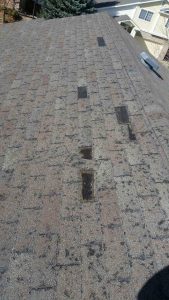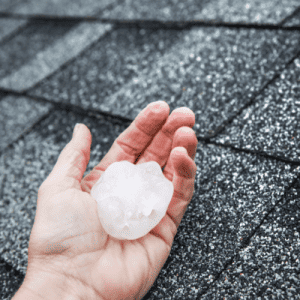With spring and summer come severe weather and hailstorms – and with those storms comes potentially severe damage to your roof. Just last year, Colorado saw over 150 damaging hail storms.
 However, not every hailstorm is created equally. Some storms produce softball-sized chunks of ice that wreak havoc on anything exposed to the elements, while other storms drop only tiny hailstones that do little more than make a lot of noise. Following these severe storms, it’s important to determine whether your roof has been damaged by hail, as this damage can result in leaks and other complications that can dramatically decrease the lifespan of your roof.
However, not every hailstorm is created equally. Some storms produce softball-sized chunks of ice that wreak havoc on anything exposed to the elements, while other storms drop only tiny hailstones that do little more than make a lot of noise. Following these severe storms, it’s important to determine whether your roof has been damaged by hail, as this damage can result in leaks and other complications that can dramatically decrease the lifespan of your roof.
It’s often difficult to tell how strong a hailstorm is or was from indoors, and the strength of such a storm can literally make or break your roof. So today, we’re sharing a complete guide to hail damage to your roof. Below, you’ll find everything you need to know about how to check for roof hail damage, how much hail damage warrants replacing or repairing your roof, and when and how to file an insurance claim so your family and livelihood is fairly covered and compensated. Let’s get started!
When to inspect your home for roof hail damage
As with all property damage, there is a limited amount of time to file an insurance claim for hail damage to your roof. We’ll go into more detail on insurance claims a bit later. Since time is of the essence, it’s important that you check for damage and, if necessary, schedule a professional inspection immediately following a hailstorm.
There are a few things you can take note of early on that may give you an idea of how much damage your roof has sustained. One smart move is to pay attention to any descriptions of hailstones you find in weather reports both during and after a severe storm. Large hail is often more destructive, though this isn’t the only metric that factors into how much damage hail leaves behind. In some ways, density is even more important than size, and the density of a hailstone can be estimated from its color. For instance, cloudy hailstones are full of air molecules and therefore less dense. Clearer hailstones, however, are denser pieces of solid ice that pack much more destructive power. Additionally, factors like the age of your roof, its slope, and the materials used in its construction play a role in how much hail damage your roof can reasonably sustain.
So, while most roofs won’t need a close inspection following pea-sized, cloudy hail; larger and denser hailstones signify that you should check more closely for damage after the storm has passed.
What does roof hail damage look like?
To begin with, the most important piece of advice when assessing hail damage to your roof is to leave up-close inspections to the experts. Climbing onto your roof is inadvisable under ordinary circumstances, if you aren’t experienced. That risk only increases when your roof may have sustained damage during the most recent storm.
With this in mind, professionals with experience climbing ladders will be able to identify signs of hail damage on a roof quite readily. Hail impacting shingles and roof tiles can dent and chip away at these materials, so any cracks or obvious surface damage is a sign that your roof has sustained damage. Loss of protective granules is a common result of hailstorms hitting asphalt roofs, while exposure of or damage to the underlying fiberglass mat suggests more severe damage. Checking for debris is also a good idea, as scattered pieces of roofing material are a telltale sign that your roof has sustained significant damage. In extreme cases, shingles may have even come loose entirely.
The good news is you can check for damage to your roof without having to get on a ladder.
Here are the signs to look for from ground level that can clue you in and prompt you to schedule a roof hail damage inspection. Any part of your home’s exterior may hold clues as to how damaging the most recent hailstorm was. If your gutters and downspouts are dented, siding is loose or broken, or decks and fencing have been damaged, your roof has likely been damaged as well. Further, check the ground around your home for pieces of shingles or other roofing debris, as this is a dead giveaway for hail damage to your roof.
Filing an insurance claim for roof hail damage
While insurance companies vary greatly in terms of their coverage, they will only cover hail damage to your roof if a claim is filed within a certain window of time. The size of this window to file a claim depends on both the insurance provider and the specific policy, but in every case, timing is critical in ensuring coverage.
The extent of hail damage required to warrant repairs or a roof replacement also varies. In general, insurance companies will want to see evidence of a certain number of hits (i.e., clear dents or missing asphalt) within a particular area on multiple sides of the roof – for example, 10+ hits within a 10×10 area on two sides of your roof. In short, the density of hail damage needs to meet the standards of your insurance policy in order to warrant coverage.
However, insurance companies typically differentiate between ‘functional’ and ‘cosmetic’ damage as well. Insurance companies will often only cover functional roof damage and not cover damage that their assessors determine to be purely cosmetic in nature. Because of the specific standards and the short window of time for filing an insurance claim, it’s important to schedule a professional roofing inspection promptly following a hailstorm during should you suspect your roof may have sustained hail damage. Then, if your professional roofing inspector believes the hail damage to your roof is substantial enough to warrant filing an insurance claim, you may be able to have your roof repaired or replaced for the mere cost of your insurance deductible.
 When does roof hail damage warrant replacement versus repairs?
When does roof hail damage warrant replacement versus repairs?
Coverage for roof replacement or repair services is ultimately up to your insurance company. However, if you’re paying out of pocket, it’s important to consider the risks and benefits of repairing versus completely replacing your roof.
There are certain clear-cut cases in which you should replace a damaged roof. If damage to your roof is widespread or your roof begins leaking as a result of storm damage, this is cause for taking such action. In the case of less extensive damage, sometimes a simple repair can add years to the lifespan of your roof, staving off a much more costly replacement.
Cases that fall somewhere in the middle are typically the trickiest to navigate. Depending on the age of your roof and the extent of the hail damage it has sustained, repairing your roof may be costlier in the long run than replacing it outright. Doing nothing can also be costly, as minor hail damage becomes a major problem for your roof if water and other elements begin seeping into the small chips and divots that hail can leave behind. Water and ice damage can wreak havoc on roofs very quickly, so even minor hail damage today should be considered for repairs.
To aid in this difficult decision, a licensed roofing expert can help you determine the extent of hail damage to your roof and identify other signs of roof deterioration. With this information, you can be confident that you’re making the most cost-effective decision for your home, your family and/or your business.
Trust your local roofing professionals
Understanding roof hail damage and assessing its severity is an important skill – not just for roofing experts and project managers, but for homeowners as well. Knowing what to look for and having a grasp of when to hire a professional to fully evaluate storm damage to your roof are vital to getting the most out of your insurance coverage. Additionally, sometimes it’s all too obvious that your roof is in need of repairs, and this helps you get a jump-start on filing a claim and scheduling repairs. Severe storms can be frightening and costly. But with the right knowledge, you can be confident and secure in the knowledge that you’ll be fairly covered and compensated for any hail damage to your roof.
Time for a roofing inspection? Contact a trusted roofer in your area to schedule a professional inspection. Not sure where to begin? Ask friends and loved ones for referrals, research online reviews with Yelp, the BBB and Google. You’re sure to find a reputable roofing company willing to complete a complimentary roofing inspection and help you explore your options.









